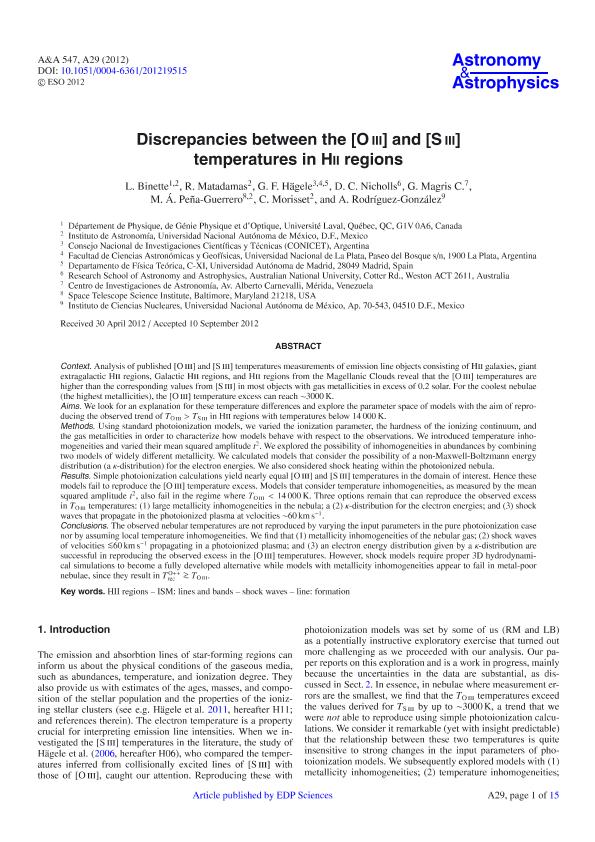Mostrar el registro sencillo del ítem
dc.contributor.author
Binette, L.
dc.contributor.author
Matadamas, R.
dc.contributor.author
Hägele, Guillermo Federico

dc.contributor.author
Nicholls, D. C.
dc.contributor.author
Magris Crestini, Gladis

dc.contributor.author
Peña Guerrero, M. Á.
dc.contributor.author
Morisset, C.
dc.contributor.author
Rodríguez González, A.
dc.date.available
2019-08-29T20:12:01Z
dc.date.issued
2012-06
dc.identifier.citation
Binette, L.; Matadamas, R.; Hägele, Guillermo Federico; Nicholls, D. C.; Magris Crestini, Gladis; et al.; Discrepancies between the [O iii] and [S iii] temperatures in H ii regions; EDP Sciences; Astronomy and Astrophysics; 547; A29; 6-2012; 29-43
dc.identifier.issn
0004-6361
dc.identifier.uri
http://hdl.handle.net/11336/82525
dc.description.abstract
Context. Analysis of published [O iii] and [S iii] temperatures measurements of emission line objects consisting of Hii galaxies, giant extragalactic Hii regions, Galactic Hii regions, and Hii regions from the Magellanic Clouds reveal that the [O iii] temperatures are higher than the corresponding values from [S iii] in most objects with gas metallicities in excess of 0.2 solar. For the coolest nebulae (the highest metallicities), the [O iii] temperature excess can reach ∼3000 K. Aims. We look for an explanation for these temperature differences and explore the parameter space of models with the aim of reproducing the observed trend of T O iii > T S iii in Hii regions with temperatures below 14 000 K. Methods. Using standard photoionization models, we varied the ionization parameter, the hardness of the ionizing continuum, and the gas metallicities in order to characterize how models behave with respect to the observations. We introduced temperature inhomogeneities and varied their mean squared amplitude t 2. We explored the possibility of inhomogeneities in abundances by combining two models of widely different metallicity. We calculated models that consider the possibility of a non-Maxwell-Boltzmann energy distribution (a κ-distribution) for the electron energies. We also considered shock heating within the photoionized nebula. Results. Simple photoionization calculations yield nearly equal [O iii] and [S iii] temperatures in the domain of interest. Hence these models fail to reproduce the [O iii] temperature excess. Models that consider temperature inhomogeneities, as measured by the mean squared amplitude t 2, also fail in the regime where T O iii < 14 000 K. Three options remain that can reproduce the observed excess in T O iii temperatures: (1) large metallicity inhomogeneities in the nebula; a (2) κ-distribution for the electron energies; and (3) shock waves that propagate in the photoionized plasma at velocities ∼60 km s -1. Conclusions. The observed nebular temperatures are not reproduced by varying the input parameters in the pure photoionization case nor by assuming local temperature inhomogeneities. We find that (1) metallicity inhomogeneities of the nebular gas; (2) shock waves of velocities 60 km s -1 propagating in a photoionized plasma; and (3) an electron energy distribution given by a κ-distribution are successful in reproducing the observed excess in the [O iii] temperatures. However, shock models require proper 3D hydrodynamical simulations to become a fully developed alternative while models with metallicity inhomogeneities appear to fail in metal-poor nebulae, since they result in T rec O++ T O iii T rec O++ ≳ TO iii. © 2012 ESO.
dc.format
application/pdf
dc.language.iso
eng
dc.publisher
EDP Sciences

dc.rights
info:eu-repo/semantics/openAccess
dc.rights.uri
https://creativecommons.org/licenses/by-nc-sa/2.5/ar/
dc.subject
Hii Regions
dc.subject
Ism: Lines And Bands
dc.subject
Line: Formation
dc.subject
Shock Waves
dc.subject.classification
Astronomía

dc.subject.classification
Ciencias Físicas

dc.subject.classification
CIENCIAS NATURALES Y EXACTAS

dc.title
Discrepancies between the [O iii] and [S iii] temperatures in H ii regions
dc.type
info:eu-repo/semantics/article
dc.type
info:ar-repo/semantics/artículo
dc.type
info:eu-repo/semantics/publishedVersion
dc.date.updated
2019-08-23T17:42:11Z
dc.journal.volume
547
dc.journal.number
A29
dc.journal.pagination
29-43
dc.journal.pais
Francia

dc.journal.ciudad
Paris
dc.description.fil
Fil: Binette, L.. Laval University; Canadá. Universidad Nacional Autónoma de México; México
dc.description.fil
Fil: Matadamas, R.. Universidad Nacional Autónoma de México; México
dc.description.fil
Fil: Hägele, Guillermo Federico. Universidad Autónoma de Madrid; España. Consejo Nacional de Investigaciones Científicas y Técnicas. Centro Científico Tecnológico Conicet - La Plata. Instituto de Astrofísica La Plata. Universidad Nacional de La Plata. Facultad de Ciencias Astronómicas y Geofísicas. Instituto de Astrofísica La Plata; Argentina
dc.description.fil
Fil: Nicholls, D. C.. Australian National University; Australia
dc.description.fil
Fil: Magris Crestini, Gladis. Centro de Investigaciones de Astronomía; Venezuela
dc.description.fil
Fil: Peña Guerrero, M. Á.. Space Telescope Science Institute; Estados Unidos. Universidad Nacional Autónoma de México; México
dc.description.fil
Fil: Morisset, C.. Universidad Nacional Autónoma de México; México
dc.description.fil
Fil: Rodríguez González, A.. Universidad Nacional Autónoma de México. Instituto de Ciencias Nucleares; México
dc.journal.title
Astronomy and Astrophysics

dc.relation.alternativeid
info:eu-repo/semantics/altIdentifier/doi/http://dx.doi.org/10.1051/0004-6361/201219515
dc.relation.alternativeid
info:eu-repo/semantics/altIdentifier/url/https://www.aanda.org/articles/aa/abs/2012/11/aa19515-12/aa19515-12.html
Archivos asociados
